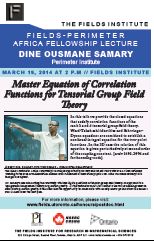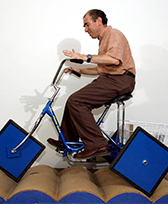|
 Fields-Perimeter
Africa Postdoctoral Fellowship Lecture Fields-Perimeter
Africa Postdoctoral Fellowship Lecture
March 19, 2014 at 2 p.m.
DINE OUSMANE SAMARY
University of Abomey-Calavi, Benin and The Perimeter Institute
Master equation of correlation functions for tensorial
group field theory (video
of the talk) (slides)
In this talk we provide
the closed equations that satisfy correlation functions
of the rank 3 and 4 tensorial group field theory. Ward-Takahashi
identities and Schwinger-Dyson equations are combined
to establish a nonlinear integral equation for the two-point
functions. In the 3D case the solution of this equation
is given perturbatively at second order of the coupling
constant. [arxiv 1401.2096 and forthcoming work].
Information
about Dr. Samary
February 3, 2014 at 2 p.m.
STAN WAGON, Mathematics and
Computer Science, Macalester College, St Paul Minnesota
Some Shocking Results in Mathematics (video
of the talk)
Some results are so shocking that they defy belief. The
talk will present several cases, from very elementary
to very sophisticated, that illustrate this point. Examples
presented will include: a modern interpretation of Hilbert's
Hotel, Julia Robinson's surprising doctoral theorem about
the rationals, a working model of a square wheel bike
and a square-hole drill, and an impossible construction
using regular tetrahedra.
|
June
6, 2014 at 11 a.m.
KONSTANTINOS
GEORGIOU,  University
of Waterloo University
of Waterloo
Lift-and-project systems for combinatorial optimization
problems; More than a decade of fascinating positive and
negative results (Video
of the talk)
A popular paradigm in approximation algorithms for intractable
combinatorial optimization problems is to first formulate
the problem at hand as an integer program and then relax
the integrality condition, giving rise to a tractable
optimization problem. At the same time, the relaxation
introduces discrepancy between the true optimum and the
optimal solution of the relaxation, which can be properly
quantified so as to correspond to the approximability
one can achieve for the combinatorial problem. In order
to cope with this discrepancy, a number of systematic
procedures, known as lift-and-project systems, have been
introduced that effectively tighten the relaxations and
that enjoy appealing algorithmic properties.
Over the last decade, numerous positive and negative
results have been established for lift-and-project systems
and for various intractable optimization problems. On
one hand, the best algorithms known for a series of optimization
problems are due to lift-and-project systems. On the other
hand, there is evidence that the limitations of lift-and-project
systems as tools in approximation algorithms indicate
the actual hardness for a number of intractable optimization
problems.
In this talk I will review the area of lift-and-project
systems. After a self-contained and high level introduction
to the systems, I will discuss a number of applications,
trying to distill the main ingredients of this algorithmic
tool. At the same time I will try to expose its weaknesses
along with the challenges that are involved in showing
positive and negative results. The exposition will be
based on numerous fascinating results of the last decade
or so..
June
6, 2013
Bernard Chazelle, Princeton University (Video
of the talk)
Why Algorithms Are Poised to Become the Language
of the Living World
May 25, 2012
Avi
Wigderson, Institute for Advanced Study
Randomness
July 11, 2011
Avner Magen Memorial Lecture Day
Ben-Gurion University
May 27, 2011
Nati Linial, The Hebrew University of Jerusalem
What is high dimensional combinatorics?
held at Massey College
.
|